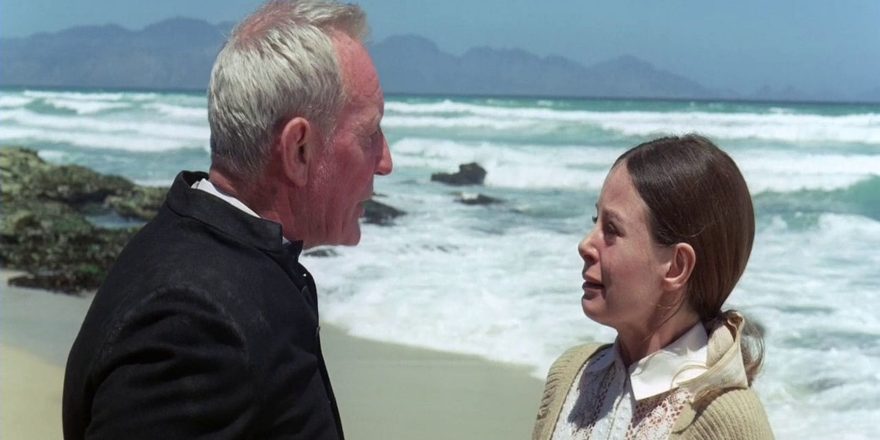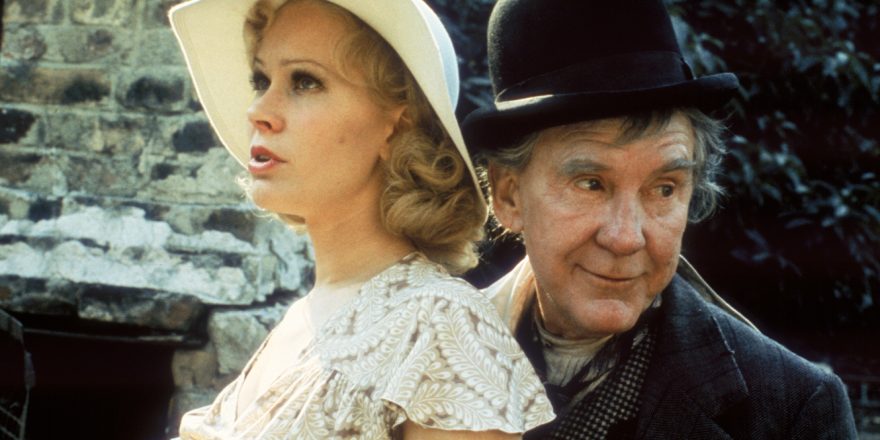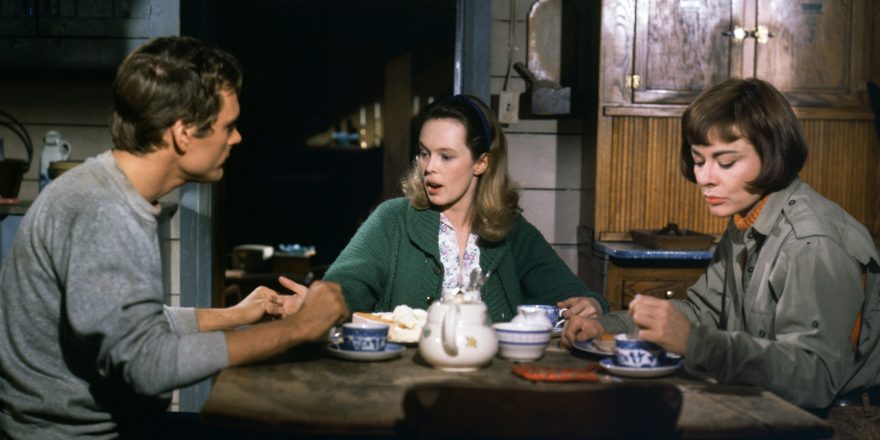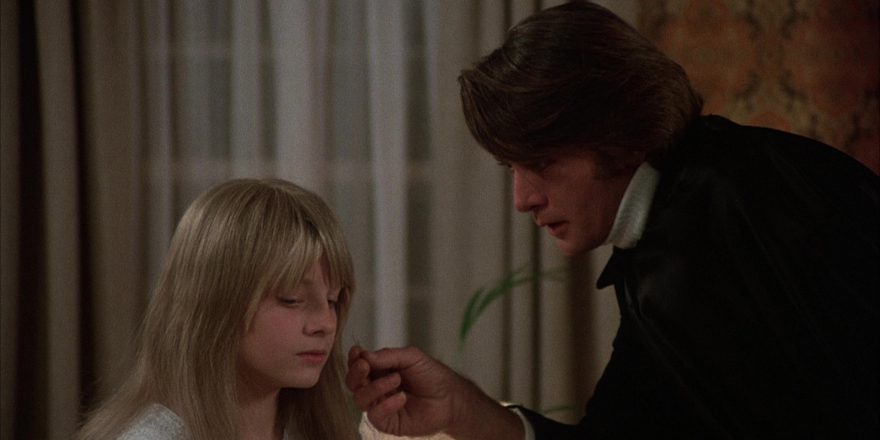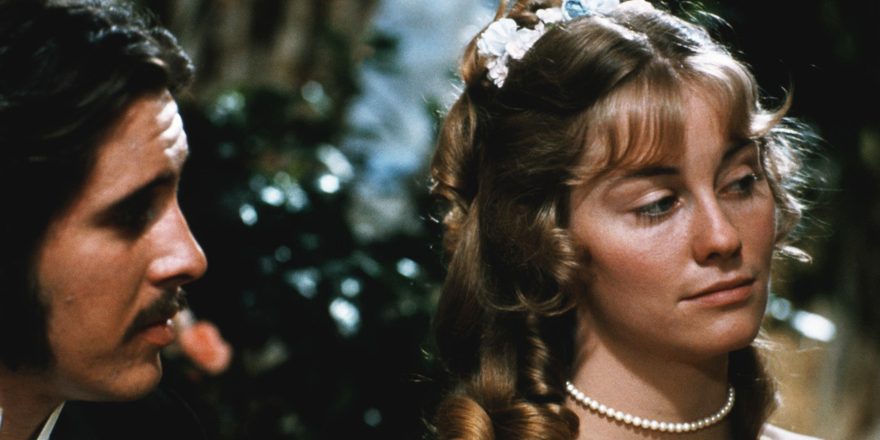It’s more than a little extraordinary that the robustly masculinist David Lean should have rounded out his fabled career with two epic films, Ryan’s Daughter (1970) and A Passage to India (1984), that both revolve around the profound sexual awakening of a young female principal character and the turmoil it engenders. In the latter part of his career, Lean was known for directing epic films told from a thoroughly masculine perspective, as tempered or problematic as that masculinity may be. In Bridge on the River Kwai (1957), two diametrically opposed male characters embody the perils of masculine bravado: Colonel Nicholson (Alec Guinness), the rigid, stiff-upper-lip British Colonel who does everything by the book, encouraging self-sacrifice and enforcing strict discipline on his men in a Japanese prison camp, and Shears (William Holden), the rugged American individualist and renegade who breaks the rules and escapes to ensure his own freedom and pursuit of happiness, but whose capriciousness and insubordination eventually catch up with him. The stolid Colonel helps his Japanese captors build the titular bridge as a symbol of pride and British patriotism and ingenuity, and to boost morale, oblivious to his own co-conspiracy with the Japanese; hedonistic Shears, given no choice by his superiors, is sent to blow it up. In this scenario, female characters are largely relegated to the sidelines in the form of a nurse as a brief love interest for Holden, and four subservient (albeit formidable) Siamese women who act as his bearers and guides. In his next epic, Lawrence of Arabia, based on the life of famed British army officer T.E. Lawrence, particularly his leadership in the Arab Revolt of 1916 (the same year as the Irish Rebellion portrayed in Ryan’s Daughter), Lean again presents an almost exclusively male world (we see only fleeting glimpses of anonymous Arab women), although Lawrence’s masculinity has a strong feminine component characterized by sensitivity and intuitiveness, not to mention his barely subtextual homosexuality witnessed by his strong emotional relationship with the two Arab boys he adopts as servants. In stark relief, Omar Sharif and Anthony Quinn play his rather brutal and decidedly virile Arab allies, although the sexual chemistry between O’Toole and Sharif is undeniable. Doctor Zhivago, Lean’s epic film based on the novel of the same name by Boris Pasternak set against the backdrop of the Russian revolution of 1917 – Lean seems to have been obsessed by the revolutionary movements of the era – is narrated by a macho male KGB commander (Guinness) whose brother, Zhivago (Omar Sharif), a doctor and poet (another sensitive and somewhat feminized male), is the hero of the tale. Zhivago’s two female love interests, his wife Tonya (Geraldine Chaplin) and his mistress Lara (Julie Christie), are both strong and stoic characters, but their lives are completely devoted to or controlled by men: Tonya as the self-sacrificing wife, mother and daughter; Lara as the wife of stern ideologue Tom Courtenay, the extreme left-wing dissident who becomes the murderous Communist Commander Strelnikov, as the lover of her mother’s friend, Rod Steiger, who rapes her, and as the mistress of Zhivago, with whom she illicitly has a daughter. In each of these three epic films, then, which forms the core of Lean’s later work, women are either barely present or completely subjugated to male authority.
David Lean’s career is somewhat of an epic in itself. He started as an editor in the 1930s, culminating with his work for Powell and Pressburger, The 49th Parallel (1941) and One of Our Aircraft is Missing (1942), and for producer Gabriel Pascal, who translated major works of George Bernard Shaw to the big screen, such as Pygmalion (1938) and Major Barbara (1941), the latter two films featuring decidedly strong proto-feminist female lead characters. When Lean transitioned to directing, he became famous not only for his epic Dickens adaptations, Great Expectations (1946) and Oliver Twist (1948), but also for his closely observed and intimate yet sumptuous and highly romantic melodramas such as Brief Encounter (1945), The Passionate Friends (1949) and Summertime (1955). (Lean, of course, adapted three plays by Noël Coward to the screen: In Which We Serve (1942), Blithe Spirit (1945), and Brief Encounter.) You might say that even before The Bridge on the River Kwai, the epic film that earned him his first Best Picture and Best Director Oscars, Lean became known for making the epic intimate and the intimate epic. Later in his career, Lean would be accused by some critics, particularly with regard to Doctor Zhivago, of concentrating too much on the melodramatic, or even sappy, romantic entanglements of the characters set against picture postcard vistas at the expense of historical accuracy or political cogency or, in the case of Ryan’s Daughter, of making a sweeping, lushly produced epic out of a somewhat simple love story which problematically relegated the Irish revolutionary war to the background. But less noted is the emergence of the female characters in his last two epics as independent and headstrong women fighting to exert their own agency and sexual autonomy in a man’s world, however problematic and torturous the results.
Ryan’s Daughter begins with the black lace parasol of Rosy Ryan (Rose for short, played by Sarah Miles, for whom her husband, Robert Bolt, wrote the screenplay specifically as an adaptation of Flaubert’s proto-feminist masterwork Madame Bovary) floating down from a cliff and falling into the sea. Lean, who always relied heavily on symbolism in the literary fashion, establishes Rosy’s parasol and her hat as major symbols in the film, both of them often being blown about by the wind, trying to escape like her own unruly spirit. The parasol is rescued by Father Collins (Lean stalwart Trevor Howard), who is fishing with Michael, the village mute (John Mills, who controversially won a Best Supporting Actor Oscar for his arguably over-the-top performance). The film is set in a small Irish village in the aftermath of the 1916 Easter Rebellion, an armed insurrection led by the Irish Republican Brotherhood (IRB) fighting for independence from United Kingdom. (A Passage to India, which could be considered a companion piece to Ryan’s Daughter, is also set against the backdrop of a nation rebelling against its occupying colonialist oppressor.) When Father Collins returns the mutinous parasol to Rosy, he discovers that she’s been reading The King’s Mistress, a romance novelette that, to the priest, is tantamount to pornography. “Have you nothing to do?” he asks her, to which she replies defiantly, “Precisely that!” “Doing nothing is a dangerous occupation!” he counters. Despite his identity as the strict religious and moral leader of the community, Father Collins, played rousingly by Howard, is somewhat sympathetic toward the girl, attempting to guide her without crushing her rebellious spirit. After one of many extravagant wide shots to come in the film of Rosy walking on the beach, here shown throwing her pulpy magazine into the sea (the film was shot on the Dingle Peninsula in the southwest of Ireland, which provides the film with pristine vistas and seascapes), Rosy encounters Charles Shaughnessy (Robert Mitchum, in one of his best performances), the middle-aged widowed schoolteacher, who gallantly fetches her restless hat when it is blown from her head. Mitchum, the Hollywood legend known primarily for playing brooding, ultramasculine men, is here cast against type as a gentle, sensitive man, akin to Lean’s poetic, elegant male characters such as Lawrence or Zhivago, more in touch, perhaps, with his feminine side. He is mild-mannered and forbearing, and he has a deep appreciation for Beethoven, whose bust sits upon his hearth, and whose 5th Symphony he is wont to play on his Victrola. Charles tells Rosy, the daughter of the local Kirrary publican, that he appreciates her for her strong opinions, but he thinks he’s much too old for her (“It’s a hangin’ matter for a middle-aged man to steal love from a young girl,” he says), and tells her he hopes some young man will sweep her up. But Rosy, already hopelessly in love with him, walks ahead and cries quietly. After he leaves, she sensually traces his large footprints with her bare feet, her sexual fetish for her masculine idol candidly exposed.
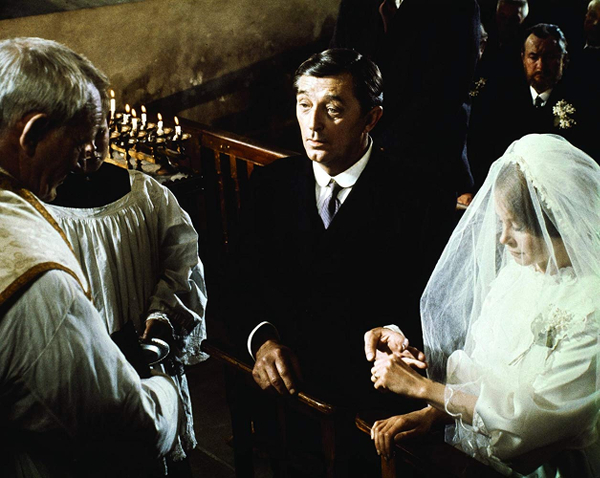
Although it has been somewhat re-assessed, Ryan’s Daughter was critically lambasted by many critics upon its release (Vincent Canby declared in the New York Times, in a particularly bitchy review, that the film “belongs to that school of very classy calendar art supported by airlines, insurance corporations and a few enlightened barber shops. It doesn’t transfigure the world, it embalms it”), a personal set-back for Lean which may have contributed to him making only one more film in his career, A Passage to India, 14 years later. But what is most curious about Lean’s final two epics, and scarcely commented on by critics – Canby doesn’t even bother to invoke Madame Bovary – is that they largely revolve around the sexuality and rebelliousness of formidable female characters who resist the dreary dominant masculine order, both sexually and politically. Critics argued, with some validity, that a stuffy, conventional British period epic like Ryan’s Daughter was absurdly outdated and conservative in the wake of such controversial and frankly sexual blockbusters as Midnight Cowboy and Easy Rider, which were indeed revolutionary films, far more formally innovative and distinctly countercultural, but which still marginalized women in favor of macho male posturing and bonding. (In retrospect, the radical hippy and underground art movements of the late ’60s were hardly a hotbed of feminist activity.) What interests me about the two last Lean films is how transgressive these more classical films are in feminist terms in direct opposition to their obvious conventionality.
What most critics failed to acknowledge is how radically identified the film is with not only the point of view of Rosy as a character (even though she is still, as the film’s title reminds us, largely recognized in terms of male possession), but also with her own sexual drive set on her terms. When Rosy waits for Charles in the schoolroom adjacent to his residence, the camera stays with her, intently listening to his footsteps behind the wall and to the Beethoven symphony he plays, setting him up as her object of desire and fetish. In a subsequent scene, Father Collins tries to mansplain marriage to Rose, telling her that sex is nothing to be afraid of, and that it’s just a function of the body. Rose, however, has already set her sights on exploring her own dreams, desires and aspirations, gazing at the sea and at the seagulls flying above. When the Father asks her what she’s expecting from marriage, he sees her focus on the gulls, and says gravely, “Wings, is it?” He already recognizes that her passions will not be so easily contained. Of course the association of the female with carnal sexuality and with essentialist tropes of nature is hardly new in film and literature, but in Ryan’s Daughter, Rose’s sexual ardor resolutely controls the narrative, and it’s the pursuit of her own pleasure, not the pleasure of the men who seek to possess her, that is the primary focus, her own sexual rebellion coinciding with the more directly political one of the Irish secessionists. It’s a formula that is reiterated in A Passage to India, in which the rebellious sexuality of the central female character, Adela Quested (Judy Davis), her very name suggesting an active woman on a mission, becomes the lynchpin of the narrative, intersecting and even influencing the parallel story of India seeking independence from its British colonialist occupier.
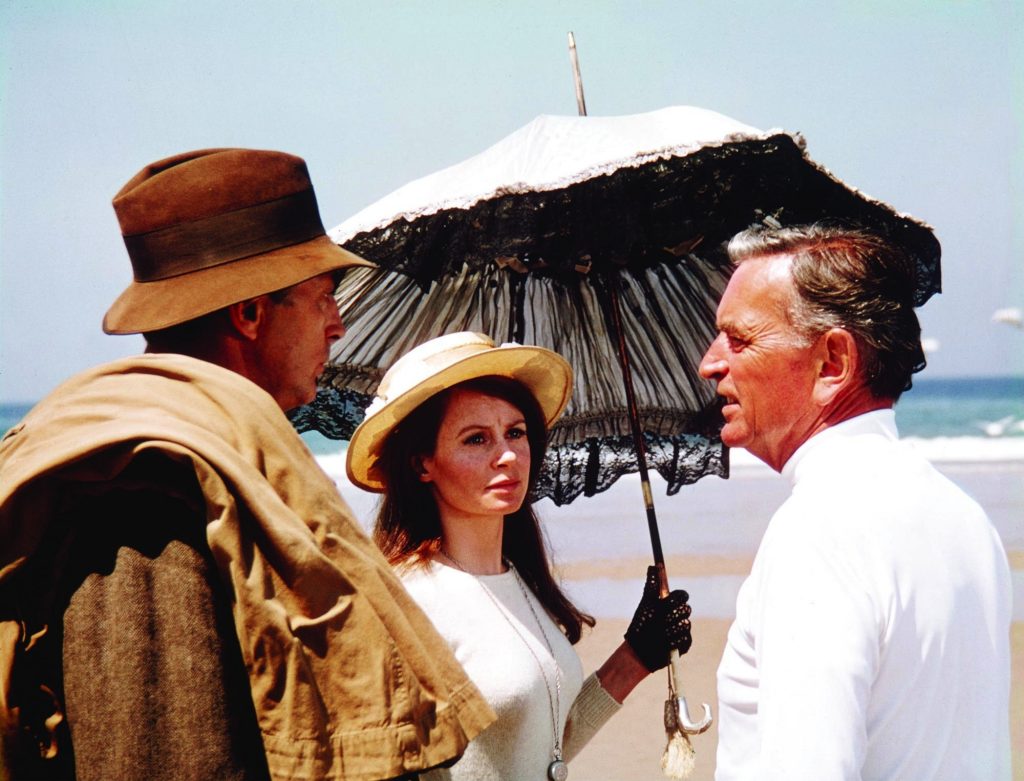
The sequence of the marriage of Rose and Charles is singular in its depiction of the ritual passing of female chattel from father to husband. After a rowdy wedding reception, the crowd parts as the bride and groom head toward the room above Ryan’s pub where the marriage will be consummated under the very roof where Rosy was born, passed from father to husband. The young men of the village, rough working-class lads, all want a turn at kissing the bride, now married to a proper, sexually repressed middle-class, middle-aged man, whom they doubt can ever satisfy her. Just as the scene becomes dangerously rape-y, the men working themselves into a sexual frenzy, Rose comes face to face with Michael, the village idiot, showing off a bit of her bridal headwear on his head. (As the Shakespearean fool, Michael mirrors and mocks various characters throughout the film, revealing their hypocrisies and absurdities.) The interruption allows Charles the opportunity to extract her from the menacing predicament, whisking her to the wedding chamber. As the raucous revelers continue partying below, pelting their window with corn, the symbol of fecundity, Charles penetrates his bride quickly, both of them fully clothed, and slides off her. The scene is significantly realized from Rose’s perspective, her POVs of the red light in the window before and after signifying her unfulfilled passion. After the “deflowering” of Rose, the symbolic flower, is completed, her face registers abject disappointment and bewilderment: her sexual thirst has not been even remotely quenched. Charles asks her if she’s all right, and they go to sleep back to back. It’s one of the most plaintive depictions of the marriage ritual in cinema, all from the female character’s perspective.
Returning to Charles’ schoolhouse residence, Rose, still headstrong, insists on carrying her own bags into the house. Although she respects and admires him, she begins to realize just how staid and prosaic her husband is, a man who presses dried flowers in books. (“I like them better in the wind, surely,” says Rose.) When Charles comes into the house with his shirt off after having completed a chore, Rose entreats him to keep it off, baldly expressing her objectification of him, a suggestion her husband says is “indecent.” Frustrated by the stifling situation she has found herself in, she walks crying on the beach, her emotions once again represented in epic grandeur, until she runs into Father Collins, who senses her restlessness. “There must be more,” she complains to him, to which he responds with chagrin, “Why, because Rosie Ryan wants it?” “Aye!” she declares emphatically, resulting in a slap from the Father that drops her to her knees. “Don’t nurse your wishes,” he warns her, “Or sure to God you’ll get what you’re wishing for.” The film neatly posits the male characters as Freudian categories, Father Collins as the superego, the institutional moral authority, and Charles as the ego, the tempered balance between the pleasure and reality principles erring far too much on the latter side.
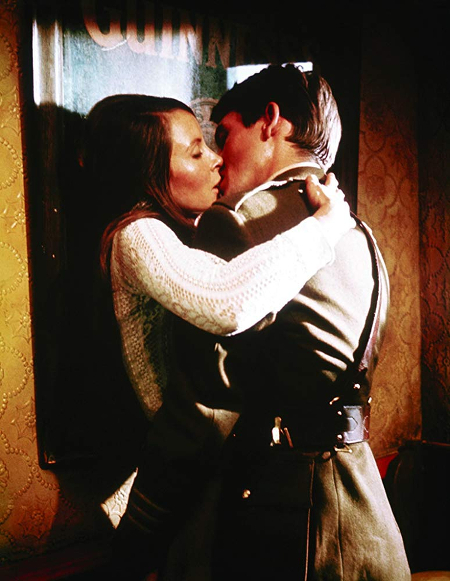
Enter the Id. At this point in the film, Rose lays her eyes for the first time on Major Doryan (gorgeous Brando facsimile Christopher Jones) when he comes into her father’s pub. The Major has taken command of the British forces in the region that seek to bring order to the agitated Irish nationalist locals after the Easter Uprising. (Although vocally opposed to the British occupation, Rose’s father, unbeknownst to her, acts as a secret informer for them.) Shell-shocked and suffering from a leg injury, the handsome Major has a flashback from his time on the Western Front and ducks under a table, where Rose joins him to comfort him, and they passionately kiss. From this point forward, the Major becomes Rose’s ultimate object of desire, her monster from the Id (he is consistently presented as a kind of Frankenstein’s monster, scarred and almost mute), his presence in the film more symbolic than realistic. Like Michael, the John Mills character, he is presented as an archetype rather than a developed character, and as such almost appears to be Rose’s sexual avatar, the masculine ideal that she has conjured to fulfill her desires. Jones is sexually objectified in the film in a manner usually reserved for female characters, silent and inscrutable, valued only for his damaged beauty and carnality. His leg injury symbolically suggests in Freudian terms that he is a castrated figure, and indeed the similarly mute and gimpy Michael constantly follows him and taunts him, a grotesque mirror image of his inner and outer wounds.
The Major may be emotionally and physically crippled (any sympathy that might have been engendered for the British commander is fortuitously erased by Jones’ wooden performance), but he can still get it up, as Rose soon discovers in the famous sex scene between the two of them in the woods, midway through the film. A mini-epic in itself, the pair fucks in a clearing intercut with gloriously-rendered shots of nature, from two strands of a cobweb glistening in the sun to dandelion seeds floating into a river as Rosy reaches glorious orgasm, her sexual awakening finally fully achieved. Everything in the scene is attributed to her senses and sexuality, so much so that the Major might just as well be a dildo. Canby relentlessly mocks the sequence, writing, “The sun peers through the leaves to make an effulgent sign of the cross, and the trees themselves go through a little series of ecstatic shudders. This kind of scenic grandeur does not define depth of emotion (it simply substitutes for it), but it does define a universe so responsive to Rosy that her moods actually dictate the weather.” Sarcasm aside, he is right about one thing: Rosy’s sexuality does define the film and is, in some regard, its true revolutionary spirit (as opposed to the highly problematic depiction of the Irish revolutionary war), something that the (mostly) male reviewers at the time, of course, completely ignored.
(As a gossipy side-note, Jones, who had had an affair with Sharon Tate, was crushed when he heard during production of the film that she had been murdered by the Manson family. In his grief, Jones was repulsed at the idea of having to enact an intimate sex scene with Sarah Miles, so Miles and Mitchum conspired to drug Jones’s breakfast, to the point of overdose, before the shooting of the scene, which may explain his almost catatonic demeanor. The magic of cinema!)

At this point, we are only at the intermission of an almost three-and-a-half hour movie, so at the risk of writing an epic myself, I will jump to how the subversive aspects of female representation (however conscious or unconscious by the film’s male creators) play out at the end. But first a note on the depiction of the Irish uprising, which, not surprisingly, many people found cringe-worthy. At a certain point in his career, Lean grandly declared that he would only heretofore direct films about revolution, making good on his promise with Lawrence of Arabia, Doctor Zhivago, Ryan’s Daughter and A Passage to India. But as Mike Prokosch of the Harvard Crimson, of all command posts of revolution, put it at the time of the release of Ryan’s Daughter, “It does seem odd to let a film about a popular Irish revolution be made by two rich upper-class English show business entrepreneurs.” (Of course he was right, in a way, but by similar logic one would have to disregard almost every film about any revolution ever made by the mainstream capitalist film industry.) The representation of the Irish rebels and the villagers that support their nationalist cause as unruly, unwashed randy heathens is egregious at best, although to give Lean some credit, his depiction of the British imperialistic military presence in both Ryan’s Daughter and A Passage to India, and, indeed, in all his later works, is always, at the very least, ambivalent, and often scathing. Alec Guinness in The Bridge on the River Kwai, as the best the British army can offer is, in the end, delusional and corrupt; Lawrence became a guerrilla fighter identified more with his Arab allies than his clueless British compatriots; Zhivago sympathized in principle with the ideals of the Communist revolution; and the British Raj are depicted as racist occupiers in A Passage to India, the only glimmer of redemption offered by the formidable Englishwoman Mrs. Moore (Peggy Ashcroft), whose distaste for British separatist rule is shared by her young charge, Adela, and schoolmaster Richard Fielding (James Fox). These ambivalences, however, were largely ignored by Mr. Prokosch of the Harvard Crimson, which declared after Ryan’s Daughter’s release that Lean should suffer the same fate as the Spaniards captured by the Incas, who melted down the gold they sought to steal from them and poured it down their throats. “David Lean,” he declared, “should be stuffed with the filthiest of dollar bills received at the box-offices of theatres running Ryan’s Daughter.” Viva la Revolución, Harvard!
The second half of Ryan’s Daughter focuses on Charles’ suspicions of his wife’s affair and its consequences when it is revealed. While with his students on the beach, Charles notices the footprints of his wife in the sand side by side with those of the wounded Major, who leaves a distinct trail owing to his leg injury. He imagines Rose and the Major together, both in their finery, appearing as if right in front of him, Rose now significantly wearing a man’s bowler hat. Rose continues to deny the affair, but when the Major’s distorted doppelgänger Michael sports a button from the Brit’s uniform in front of the villagers and acts out their tryst in pantomime, Rose’s transgression – not only committing adultery, but also sleeping with the enemy – is exposed. When Rose tries to buy groceries at the village store, the female proprietor refuses to serve her, saying, “There’s loose women, then there’s whores, then there’s British soldier’s whores!”
A long, legendary sequence follows, alone worth the price of admission, in which firearms and grenades from a Russian boat are floated to the coast to support the Irish insurrection against the British, and the villagers help pull the boxes of weaponry from the sea during a hellacious storm. (Of course, Lean being Lean, he waited to shoot it during an actual major storm, putting the cast and crew through a harrowing experience. Lean was nothing if not megalomaniacal, not entirely unlike Colonel Nicholson in Bridge on the River Kwai.) When Tim O’Leary, the leader of the rebellion, tries to escape with the weaponry, the British soldiers are waiting for him, tipped off by Rosy’s father. O’Leary tries to get away, but the Major shoots and wounds him, precipitating another attack of shell-shock, and compelling Rose to try to comfort him again, thereby further exposing their affair. Rose’s cowardly father stays silent, allowing everyone to believe that his daughter is the informer, which sets up the finale of the film.
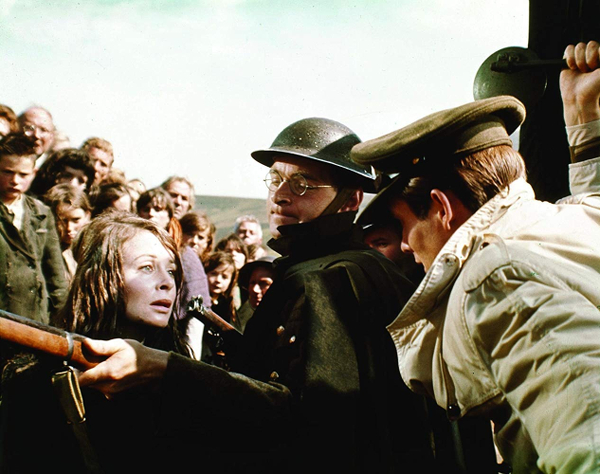
Back at the schoolhouse, Charles tells Rosy he knew of the affair all along, and that night, as if in a trance, she leaves his bed to have one final fling with the Major, whose sexual magnetism summons her like Dracula. Charles is crushed by this final insult, and walks off half-mad to the beach in his nightgown, where Father Collins finds him the next day, bringing him his pants and boots and coaxing him back home. Charles and Rose finally agree to separate, although she says her tryst with the Major is over. Charles suggests they both move away from the village, sell all their possessions, except the Victrola, and split the profits equally.
In the subsequent sequence, an angry mob of villagers storms the schoolhouse. The women pull Rose out of the house and shave her head, while one of the men strips off her clothes. Rose’s sexual rebellion can no longer be sustained or tolerated, so as the scarlet woman she must be (symbolically) raped and publicly slut-shamed. Charles, the ineffectual, feminized male, tries desperately to save her, but unsuccessfully, so it’s Father Collins who comes to her rescue, punching the man who stripped her. Although the violation of Rose in Ryan’s Daughter and the alleged sexual violation of Adela Quested in the cave by the Indian Dr. Aziz in A Passage to India are completely different in context, they do have one thing in common: it’s the sexual awakening of the young female lead character, the one with whom we are perhaps the most identified in the film, a sexual energy running parallel to and intersecting the revolutionary political events of the story, that drive the narratives. Adela, who had the audacity to make friends with and be sexually attracted to an Indian man, finally admits in court that she was not violated by Dr. Aziz, her admission and his innocence becoming a further catalyst for the Indian struggle for independence from British rule. Rose is violated by the insurrectionaries as a scapegoat for collusion with the British, but in both films it’s the women’s personal quests, their own private sexual revolutions, that are ultimately punished.
In the final scenes, it’s the relationship that develops between Rose and Charles after her violation that makes the film unique. The two sit in their schoolhouse residence and drink whiskey together, more like compatriots than man and wife. After everything that has happened, they have emerged, ultimately, as friends and peers, bonded by their ostracization from the community. A shot of Charles lighting a match is juxtaposed with the sound of an explosion coming from the beach, where the Major has blown himself up with the washed up munitions, Rose’s epic sexual fire finally extinguished. The next day, the abject pair is forced to walk the gauntlet through the village, the villagers silent, peeking at them through curtains, before actively whistling and yelling at them to never return. “A rousing send-off,” says Rose, still defiant. Rose stops by at the pub to say goodbye to her father, for whom she has heroically taken the fall. Her father recognizes how lucky she is to have had a husband like Charles who has stood by her through everything, saying, “When you married him, I thought you could have done better. Now, I’m not sure they come much better.” As they wait for the bus to Dublin with Father Collins, the Victrola, symbol of their more poetic alliance, their only possession, the humiliated Rose and her faithful Charles have become social outcasts together. Rose’s hat blows off one last time, and Charles gallantly runs after it. Father Collins gives them enough money to rent a room in the city, and he strongly suggests to Charles that he should not part with Rose. The inference, as they ride away on the bus, is that the pair will stick together, perhaps more as allies than man and wife, with Rose an equal partner rather than chattel. It’s an ending not unlike that of another epic Hollywood movie about revolution, Warren Beatty’s Reds, in which the sexually autonomous Louise Bryant (Diane Keaton) and her husband John Reed (Beatty) agree, ultimately, to live not as man and wife, but as “comrades.”



